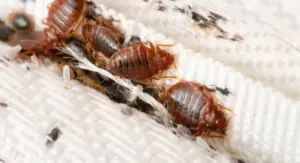Can Bed Bugs Bite Through Clothes?
Understanding Bed Bugs
Bed bugs, often considered the bane of many sleepers, have been around for centuries, coexisting with humans and feeding off our blood. These tiny creatures have a fascinating evolutionary history, having adapted to various environments and conditions. While they were almost eradicated in the mid-20th century due to the widespread use of DDT, they’ve made a comeback in recent decades. This resurgence is attributed to increased global travel and resistance to many common pesticides.
Their adaptability and resilience make them a formidable pest. They can thrive in various climates and are not just limited to beds, as their name suggests. From public transport seats to luxury hotel rooms, bed bugs are not picky about where they set up shop, making them a universal problem.
Brief Description
Bed bugs are small, nocturnal insects that belong to the Cimex genus. Adult
Although they lack wings and cannot fly, they move quickly, especially when seeking a host or escaping from threats. Their appearance can be quite deceptive, as their harmless look contrasts sharply with the discomfort they can cause.
Lifecycle and Habits
The life of a bed bug begins as a tiny, translucent egg, often laid in hidden locations like mattress seams or cracks in furniture. Once hatched, the nymphs, which look like miniature versions of adult
Bed bugs are primarily nocturnal, preferring to feed under the cover of darkness. Their peak feeding time is usually an hour or two before dawn. They are attracted to the carbon dioxide we exhale and the warmth of our bodies. A single feeding session can last anywhere from 3 to 12 minutes, after which they retreat to their hiding places.
- Kills Bed Bugs and Bed Bug Eggs
- Kills Fleas and Dust Mites
- Non-staining, Leaves No Odor
Can Bed Bugs Bite Through Clothes?
The idea of
While it’s possible for them to bite through thin pajamas or t-shirts, thicker clothing materials can act as a deterrent. But remember,
The Myth vs. Reality
There’s a prevalent myth that
It’s also worth noting that
You might be interested in: What Kills Bed Bug Eggs Instantly
Factors Influencing Their Bites
Several factors can influence whether a bed bug will bite through clothing. The type and thickness of the fabric are primary determinants. For instance, a lightweight summer dress might offer little protection compared to a heavy sweatshirt. The tightness of the clothing also plays a role; loose garments might provide easier access to the skin.
Additionally, the bed bug’s hunger level can influence its determination. A starving bed bug might be more persistent in trying to access the skin, even if it means navigating through clothing. On the other hand, a recently fed bug might not be as motivated.

Why Bed Bugs Prefer Bare Skin
Bed bugs have evolved over thousands of years to become efficient bloodsuckers. Their preference for bare skin is primarily due to the ease of access. When they bite,
Furthermore,
- 100% Kill Efficacy Bedbugs, Mites, Eggs
- Lasting Protection
- USDA BIO-certified
- Plant Extract Based & Non-Toxic
- Child & Pet Safe
Types of Clothes Bed Bugs Can and Can’t Bite Through
Bed bugs can bite through thin fabrics like cotton t-shirts, lightweight pajamas, or stockings. These materials are easy, easier for the bed bug’s mouthparts to penetrate, giving them direct access to the skin. On the other hand, thicker fabrics like denim, wool, or synthetic materials pose a challenge for these pests. The dense weave of these materials makes it difficult for
Moreover, tight clothing can also deter
Preventive Measures
Prevention is always better than cure, especially when it comes to
Another effective preventive measure is to avoid bringing second-hand furniture into your home without thoroughly inspecting and cleaning it.
Choosing the Right Clothing
When dealing with a potential bed bug infestation, your choice of clothing can play a crucial role in minimizing bites. Opt for light-colored clothing as it makes it easier to spot
Bed Bug Repellents for Clothes
There are several repellents available that can be applied to clothing to deter
How to Identify Bed Bug Bites
Bed bug bites often appear as small, red, itchy welts. They can be in a straight line or clustered together, depending on how the bug has moved while feeding. While some people might not react to bed bug bites at all, others can have allergic reactions, leading to larger red welts or even blisters. It’s essential to note that bed bug bites can look similar to bites from other insects, so it’s crucial to look for other signs of an infestation, like the bugs themselves or their fecal spots.
- Bedbug Detection and Protection
- Effective, Heav Duty, Versatile Design
- Use under bed posts and furniture legs
- Bed bugs climb in but cannot climb out
Treatment for Bed Bug Bites
If you’ve been bitten by
How to Get Rid of Bed Bugs
Getting rid of
You might be interested in: How Long Can Bed Bugs Live Without a Host?
FAQs: Can Bed Bugs Bite Through Clothes?
Do
Primarily, yes, but they can also feed during the day if they’re hungry.
How long can
They can survive several months without a blood meal.
Are bed bug bites dangerous?
Generally, no, but they can cause allergic reactions in some people.
How do
They can hitch a ride on luggage, clothing, and used furniture.
Can
No, they cannot fly or jump.







